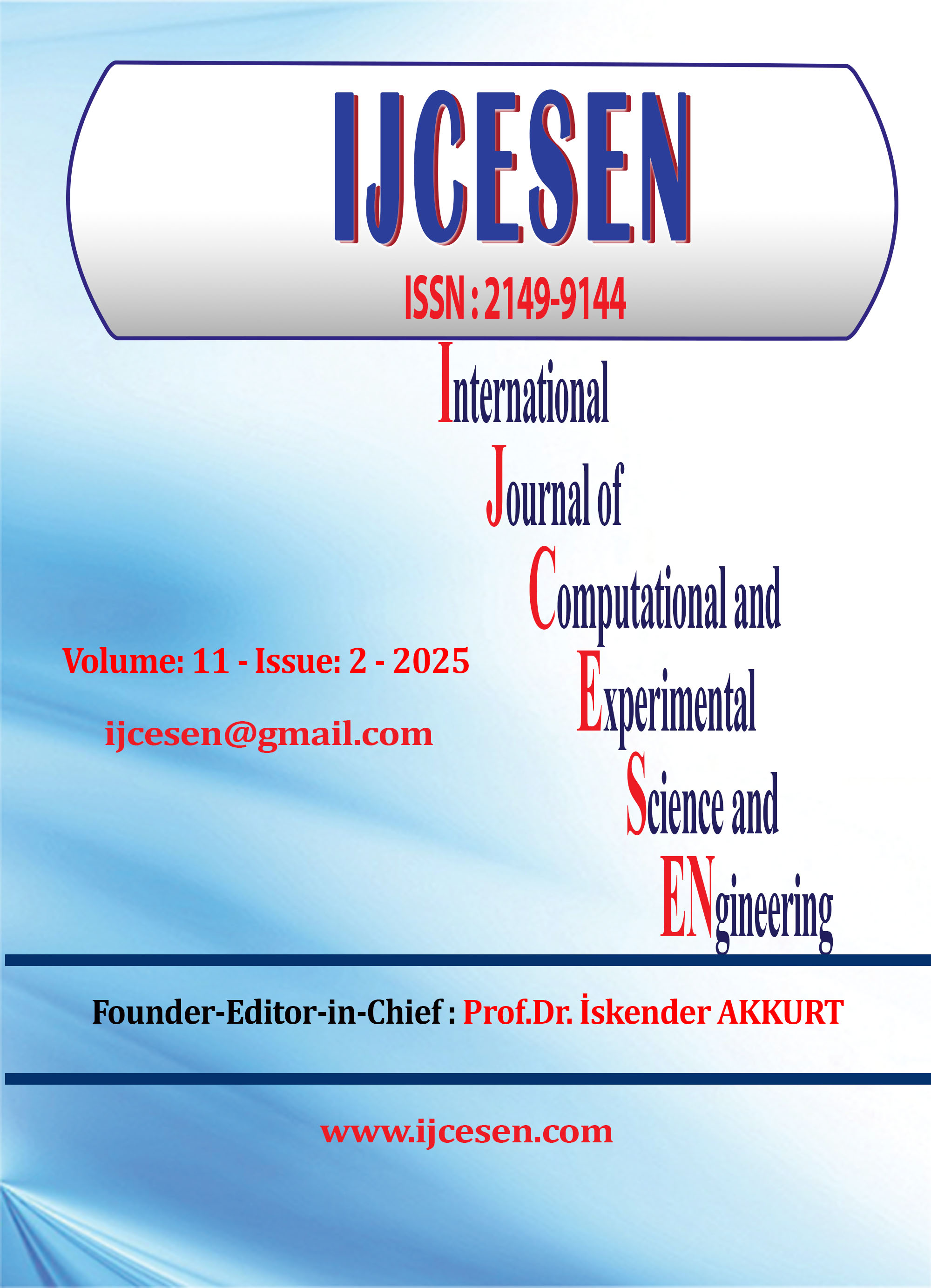AI-Driven Heart Disease Prediction Using Machine Learning and Deep Learning Techniques
DOI:
https://doi.org/10.22399/ijcesen.1669Keywords:
Heart Disease Prediction, Machine Learning Deep Learning, XGBoost, AI in HealthcareAbstract
Heart disease remains a leading cause of mortality worldwide, necessitating early detection and prevention strategies. This study explores machine learning (ML) approaches for predicting heart disease using patient datasets. Various ML algorithms, including Logistic Regression, Naive Bayes, Support Vector Machine (SVM), K-Nearest Neighbors (KNN), Decision Tree, Random Forest, XGBoost, and an Artificial Neural Network (ANN), were implemented to classify heart disease presence. The Random Forest model achieved the highest accuracy of 95%. The findings demonstrate that ML can significantly enhance heart disease prediction, aiding early diagnosis and treatment.
References
M. Mandava and S. V. Reddy, (2024). MDensNet201-IDRSRNet: efficient cardiovascular disease prediction system using hybrid deep learning, Biomedical Signal Processing and Control, 93;106147, doi: 10.1016/j.bspc.2023.106147
L. Neri et al., (2023). Electrocardiogram monitoring wearable devices and artificial-intelligence-enabled diagnostic capabilities: a review, Sensors, 23(10);4805, https://doi.org/10.3390/s23104805.
M. McGilvray et al., (2022). Electronic health record-based deep learning prediction of death or severe decompensation in heart failure patients, JACC: Heart Failure, 10(9);637–647, https://doi.org/10.1016/j.jchf.2022.05.007.
T. Cao, (2022). The design and research of hospital integrated information management platform, Computer Age, 10;150–154 https://doi.org/10.3969/j.issn.1006-8228.2022.10.050.
A. Tiwari, A. Chugh, and A. Sharma, (2023). Ensemble framework for cardiovascular disease prediction, arXiv preprint arXiv:2306.09989. https://arxiv.org/abs/2306.09989.
B. S. Ingole et al., (2024). Advancements in heart disease prediction: a machine learning approach for early detection and risk assessment, arXiv preprint arXiv:2410.14738, 2024.
A. K. S. N. Reddy et al., (2023). Early prediction of heart disease with data analysis using supervised learning with stochastic gradient boosting, Journal of Engineering and Applied Science, 70;122. https://doi.org/10.1186/s44147-023-00274-2.
R. Nadarajah et al., (2023). Prediction models for heart failure in the community: a systematic review and meta-analysis, European Journal of Heart Failure, 25(10);2970–2984. https://doi.org/10.1002/ejhf.2934.
Kumar, A., Gupta, M., Varshney, A., Kumari, S., & Sahu, R. N. Artificial Intelligence in Cardiac Healthcare: Advancements in Managing Coronary Artery Disease and Acute Coronary Syndrome.
I. Yekkala et al., "Prediction of heart disease using ensemble learning and particle swarm optimization," in 2017 International Conference on Smart Technologies for Smart Nation (SmartTechCon), pp. 691–698, 2017. [Online]. https://doi.org/10.1109/SmartTechCon.2017.8358495.
S. Saha et al., (2024). Heart disease prediction using machine learning algorithms: performance analysis," in 2024 3rd International Conference on Advancement in Electrical and Electronic Engineering (ICAEEE), 2024. https://doi.org/10.1109/ICAEEE62219.2024.10561820.
M. Hongyun, (2023). Risk prediction of coronary heart disease based on machine learning algorithm, Journal of Guangdong Medical University, https://doi.org/10.1016/j.gdmu.2023.01.005.
C. Sharma et al., (2021). Features contributing towards heart disease prediction using machine learning," Workshop on Advances in Computational Intelligence at ISIC 2021, https://doi.org/10.1109/ISIC50164.2021.9257680.
T. Salem, (2018). Study and analysis of prediction model for heart disease: an optimization approach using genetic algorithm, International Journal of Pure and Applied Mathematics, 119(16);5323–5336, https://doi.org/10.12732/ijpam.v119i16.42.
M. Connell, (2021). Digital image analysis of ultrasound images using machine learning to diagnose pediatric nonalcoholic fatty liver disease, Clinical Imaging, 77;62–68. https://doi.org/10.1016/j.clinimag.2021.01.020.
J. Vijayashree, (2018). A machine learning framework for feature selection in heart disease classification using improved particle swarm optimization with support vector machine classifier, Program Computing Software, 44;388–397, https://doi.org/10.1134/S0361768818060040.
C. Harding, (2016). Longitudinal study of cardiometabolic risk from early adolescence to early adulthood in an ethnically diverse cohort, BMJ Open, 6;12 https://doi.org/10.1136/bmjopen-2016-013221.
S. Ansarullah and P. Kumar, (2019). A systematic literature review on cardiovascular disorder identification using knowledge mining and machine learning method, International Journal of Recent Technology and Engineering, vol. 7, no. 6S, pp. 1009–1015, https://doi.org/10.35940/ijrte.C1251.1086S19.
M. A. Jabbar et al., (2016). Prediction of heart disease using random forest and feature subset selection, in Advances in Intelligent Systems and Computing, 394;187–196, https://doi.org/10.1007/978-3-319-28031-8_19.
Hafez, I. Y., & El-Mageed, A. A. A. (2025). Enhancing Digital Finance Security: AI-Based Approaches for Credit Card and Cryptocurrency Fraud Detection. International Journal of Applied Sciences and Radiation Research , 2(1). https://doi.org/10.22399/ijasrar.21
Fowowe, O. O., & Agboluaje, R. (2025). Leveraging Predictive Analytics for Customer Churn: A Cross-Industry Approach in the US Market. International Journal of Applied Sciences and Radiation Research, 2(1). https://doi.org/10.22399/ijasrar.20
Ibeh, C. V., & Adegbola, A. (2025). AI and Machine Learning for Sustainable Energy: Predictive Modelling, Optimization and Socioeconomic Impact In The USA. International Journal of Applied Sciences and Radiation Research, 2(1). https://doi.org/10.22399/ijasrar.19
M. Revathy Meenal, & S. Mary Vennila. (2025). Renyi Entropy Predictive Data Mining And Weighted Xavier Deep Neural Classifier For Heart Disease Prediction. International Journal of Computational and Experimental Science and Engineering, 11(1). https://doi.org/10.22399/ijcesen.1000
K.S. Praveenkumar, & R. Gunasundari. (2025). Optimizing Type II Diabetes Prediction Through Hybrid Big Data Analytics and H-SMOTE Tree Methodology. International Journal of Computational and Experimental Science and Engineering, 11(1). https://doi.org/10.22399/ijcesen.727
Bandla Raghuramaiah, & Suresh Chittineni. (2025). BreastHybridNet: A Hybrid Deep Learning Framework for Breast Cancer Diagnosis Using Mammogram Images. International Journal of Computational and Experimental Science and Engineering, 11(1). https://doi.org/10.22399/ijcesen.812
G. Jithender Reddy, & T. Uma Devi. (2025). Algorithms for Enhanced Security and Data Sharing in Blockchain-Driven Healthcare Systems. International Journal of Computational and Experimental Science and Engineering, 11(2). https://doi.org/10.22399/ijcesen.1162
M. Husain Bathushaw, & S. Nagasundaram. (2024). The Role of Blockchain and AI in Fortifying Cybersecurity for Healthcare Systems. International Journal of Computational and Experimental Science and Engineering, 10(4). https://doi.org/10.22399/ijcesen.596
D, jayasutha. (2024). Remote Monitoring and Early Detection of Labor Progress Using IoT-Enabled Smart Health Systems for Rural Healthcare Accessibility. International Journal of Computational and Experimental Science and Engineering, 10(4). https://doi.org/10.22399/ijcesen.672
Çakmak, A. (2024). Surgery and risks of transcatheter aortic valve replacement (TAVR) in Low Surgical Risk patients with aortic stenosis: Surgery and risks of transcatheter aortic valve replacement (TAVR) in Low Surgical Risk patients with aortic stenosis. International Journal of Computational and Experimental Science and Engineering, 10(4). https://doi.org/10.22399/ijcesen.616
Olola, T. M., & Olatunde, T. I. (2025). Artificial Intelligence in Financial and Supply Chain Optimization: Predictive Analytics for Business Growth and Market Stability in The USA. International Journal of Applied Sciences and Radiation Research, 2(1). https://doi.org/10.22399/ijasrar.18
Downloads
Published
How to Cite
Issue
Section
License
Copyright (c) 2025 International Journal of Computational and Experimental Science and Engineering

This work is licensed under a Creative Commons Attribution 4.0 International License.





